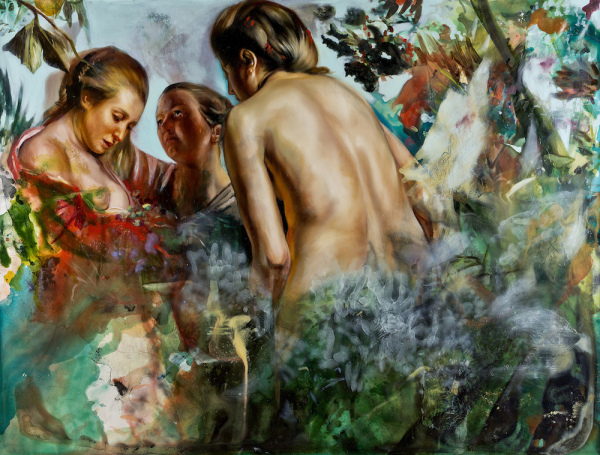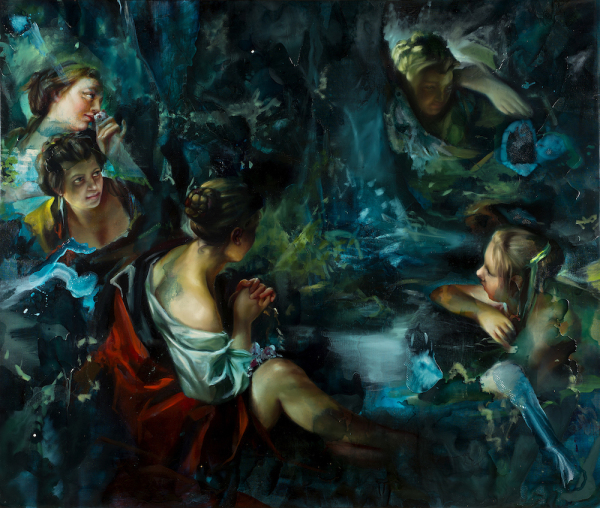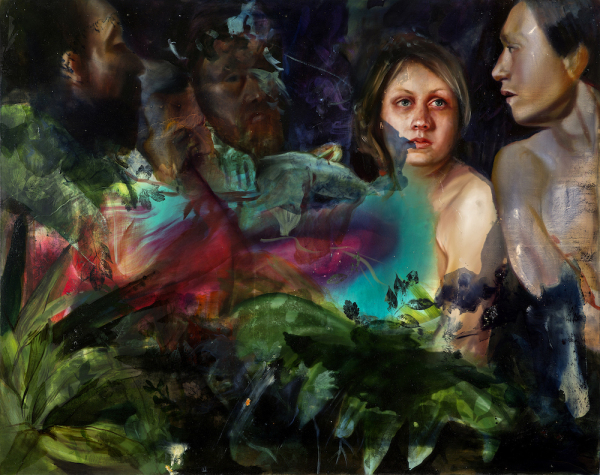Since at least 2004, Angela Fraleigh has been preoccupied by the way violence is subsumed within desire. But while, for instance, she may directly reference The Rape of Europa among others in her most recent paintings at Inman Gallery in Houston she has characteristically been less interested in more obvious acts of violence and more so in the subtle moments that nevertheless fuel sexuality: of wanting to control, of wanting to be controlled, of rapture, and of surrender.
Despite Fraleigh’s impulse to unearth sexual undercurrents and expose violent subtleties, her work has taken a decidedly feminist turn. While much of Fraleigh’s previous painting has been personal (images of herself and loved ones have frequently shown up in her work), she seemed more focused on capturing the liminal moments in intimacy between desire and aggression, and less preoccupied with how that visual representation of desire has affected women at large throughout the course of history. But this time she has plucked women who have been raped, wrecked, ravaged, exploited, or even disregarded from Baroque and Rococo paintings, where they have been frozen as glorified objects, meant for little else than our visual devouring.
But desire doesn’t always necessarily revolve around sex, and although many of the paintings in Fraleigh’s latest series still seem sexually charged they also seem imbued with other kinds of desire that can exist between women, like friendship, love, camaraderie, and tenderness. How the women interact with one another and the heightened tension and uncertainty about what’s going on between them is of the utmost importance—and it is this uncertainty that propels her paintings further further, that keeps them from just being more obvious art about the male gaze.
The exhibition’s title is taken from a Truman Capote’s essay “Ghosts in Sunlight,” in which he discusses how the movie created from his book, In Cold Blood, despite being twice removed from the original incident (the robbery and murder of a family), felt surprisingly and disturbingly more real. This definitely applies in Fraleigh’s paintings, where she rips and reappropriates the ghosts of Baroque and Rococo masterworks, rescuing them from their original contexts, and injecting in them fresh, ambivalent narratives.

Something has already started to live in you that will live longer than the sun, 2014
oil, gouache, acrylic and galkyd on canvas, 66 x 86 inches
The most compelling piece is Something has already started to live in you that will live longer than the sun. Three women stand, huddled, knee deep in a lush garden of murky, cloudy blues, greens, and purples. It is unclear if they are emerging from or being swallowed by color. A forlorn woman glances down at her own exposed breasts as a scarlet robe slides off her right shoulder as a matronly woman strokes her head in concern. Another nude woman crouches, bending down to reach for something within a dense fog. By the looks on their faces, we can’t tell if they are mourning a death or about to make love. Titillating, tender, sad, and voracious: Fraleigh gives us the first sentence of a thousand stories.

though they crowded between, and usurped the kiss of my
mouth, their breath was your gift, their beauty, your life., 2014 oil and synthetic resin on linen, 72 x 84 inches
By contrast, Though they crowded between, and usurped the kiss of my mouth, their breath was your gift, their beauty, your life is a missed opportunity. A group of five women frame the canvas, all facing center, but instead of interacting with each other they all seem stuck on their own individual islands, gazing at a swath of moonlit color in the middle. In Something has already started . . . the power lies in the charged, confusing, ambivalent narratives that arise when we watch the women comfort, succumb to, or shy away from each other—when we know something is happening, but are only privy to a fraction of the story. In Though they crowded between . . . we are provided with the communal without any of that fraught sensuality. Instead, we get a heavy-handed bath of glowing, mystical blues and greens, as if we are stuck in an all-female sequel to FernGully.
Fraleigh used to cover her paintings in an even coat of glossy resin—a sculptural move that was intended to both entice and repel visual engagement. She has largely broken with that tradition in Ghosts in the Sunlight. With the exception of Though they crowded between . . . which still uses resin, most of her interventions come in the form of either gold leaf or galkyd (a high-viscosity painting medium), again with varying degrees of success.

you’ll see me from a trillion miles away, 2014 oil on canvas
48 x 60 inches
Like Something has already started . . . , You’ll see me from a trillion miles away . . . intersperses the galkyd in a seemingly seamless orgy of sheen, color, oil paint, and bodies. It’s an extremely intelligent move; instead of simply creating a gloss on top of the entire picture plane, the material involves itself with what’s actually going on inside the painting, conjuring a kind of immanence from within instead of acting as an application on top. With Something has already started . . . and you’ll see me . . ., Fraleigh uses the galkyd as an agent of birthing and vomiting, of emergence and secrecy.

Ghosts in the Sunlight, 2014 oil and metal leaf on canvas 90 x 66 inches
The gold leaf, particularly in the painting Ghosts in the Sunlight where it does the least amount of intervening, feels more decorative, more like a frivolous application. Perhaps the one exception would be from these your future song may rise, where the gold leaf climbs up the woman’s neck like a vine or a virus. In carried by voices, Fraleigh gets more aggressive with the gold leaf; it cuts across and obscures two women playfully crouching and reclining, as if sunbathing. The aggression contrasts nicely with the serene sky-blue background and the carefree attitude of the women, but it lacks the multidimensionality that came with Something has already started and you’ll see me. In fact, the most interesting parts of the painting are when body parts get obscured, like the top of the woman’s leg reclining on the right—but Fraleigh did this with the blue oil paint, not the gold leaf.
Ironically, Fraleigh’s most compelling abstractions are the paintings that are fully representational: the group of eleven portraits in Inman’s South Gallery. Although modest in stature at 14”x11” each, they pack all the sensuality, mystery, drama, and open-ended storytelling she’s after in the first place. This time her abstractions don’t come from interventions of color, gold leaf, or galkyd, but of cropping. It’s a brilliant way of lending each of these women autonomy while also robbing them of their bodies. Here Fraleigh facilitates possible narratives while simultaneously denying us any actual resolution. The installation as a whole oddly commands reverence and religiosity: the truth takes time to unwind hangs on its own wall, glowing like Piss Christ.

We held hands beneath the dirt, 2014 oil on canvas
14 x 11 inches
The most gripping of all the portraits is We held hands beneath the dirt. Here we get such a close cropping of the woman’s face that the top of her head is cut out. The woman looks down, either at her own body or something beneath her, with an expression that is unclear, yet dramatic and emotive. We can’t tell if she is recoiling in disgust or writhing in ecstasy, nor are we allowed to find out.
Ghosts in the Sunlight, for the most part, stays loyal to Angela Fraleigh’s typical mannerisms: conjoining representation and abstraction to envelop the viewer in ambivalent narratives. But the cropping, use of gold leaf and galkyd, and changing the way she uses resin, and feminist undertones are fairly major breaks from her previous work, and each comes with its fair share of success and failure. But one thing is certain: it will be very exciting to see what she comes up with next.
Ghosts in the Sunlight will be on view at at Inman Gallery in Houston until January 3, 2015.


